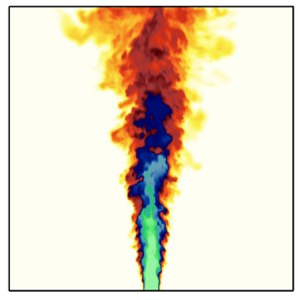Article contents
Turbulent transfer and entrainment in a low-density jet
Published online by Cambridge University Press: 08 August 2023
Abstract

We investigate the dynamics of a low-density round jet, with a focus on the mechanisms governing the turbulent momentum and mass transfers as well as on the entrainment of ambient fluid. To that purpose, we combine a theoretical analysis, laboratory experiments and numerical simulations. The theoretical analysis relies on a general formulation of the entrainment decomposition for the case of large density differences, revealing the role of the processes contributing to the entrainment: turbulent kinetic energy production and variation in the shape of the mean velocity radial profiles. The spatial evolution of these terms has been evaluated by means of challenging experiments, providing a unique data set of combined velocity and density statistics of a low-density jet and an air jet. The same flows are investigated by means of large-eddy simulation (LES). Other than for providing complementary information on flow statistics, LES is here used to investigate the role of varying conditions imposed at the source, notably concerning the shape of the inlet velocity profile and the presence of a bottom wall surrounding the source. Experimental and numerical results provide clear insight on how a reduced density within the jet enhances the turbulent kinetic energy production (compared to an iso-density jet) and modifies the shape of the mean velocity profiles. Despite its clear influence on the flow statistics, the reduced density has overall little influence on the entrainment rate, which also shows little sensitivity to varying source conditions.
- Type
- JFM Papers
- Information
- Copyright
- © The Author(s), 2023. Published by Cambridge University Press
References
- 7
- Cited by



